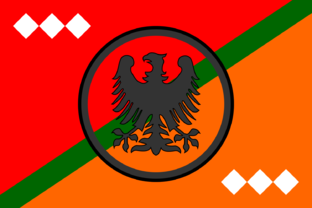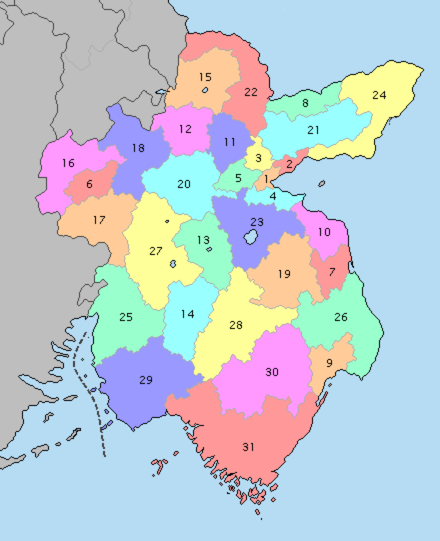Solea
The Socialist Autarky of Solea (Auxiliary Soleani: zekáhi zoletha apa) /sɤlɛʔa/ is a sparsely populated socialist constitutional e-democratic republic located on the continent of Amalthea. It is a founding member of the Free Federation. At the last census in 983, Solea had a population of just over 12.6 million humans and saguans. Solea is an extremely environmentalist and autarkic nation, rejecting capitalist-imperialist views of civilization. Domestic policy focuses on preservation of the environment for the benefit of all life, sustainability, and eco-friendly industry. In addition, Solea is home to over 200 designated national parks and vast wildlife sanctuaries where settlement is extremely limited.
The country has no form of currency. The economy of Solea relies instead on a federal rations system. Each individual carries a card or Personal Information and Identification System (<soleani>) which tracks the individual's allowance for any desired good—necessity or luxury. Federal rationing is based on recent production and availability of goods within the nation. The PIIS is frequently updated with the internal flow of goods via the internet to ensure the population's basic needs are met. Any citizen of Solea may move freely within the Free Federation at their own request. Immigration and travel are tightly regulated from other regions to preserve the low population, though the restrictions are more relaxed for residents of the Free Federation.
Lysteriokans first made contact with the nation of Solea in <>, when Aeridanish explorers tried to set up colonies and mercantilist trading settlements, leading to decades of skirmishes with the Empire of Aeridani (and to a lesser extent Aiyota), millions of deaths on both sides of the Serkr Ocean from diseases, and the city-state of Zapfna.
Contents
Etymology
The name Solea derives from the name of the river zolekh which runs through the Soleani capital city Saelunavvk (zeilunavvuk').
The spelling is a matter of debate among linguistic scholars. During the Soleani romanization was updated during the <> century, spellings of place names were preserved. Some linguists find it overdue to update the spelling of the nation in international contexts to zoletha, while others think it would be too prescriptivist to force an orthography in addition to causing far different approximations of the name rendered by foreign speakers unfamiliar with Standard Soleani.
History
Prehistoric Solea was inhabited by primitive saguans which arrived in the Solekh Valley from the west nearly 800 thousand years ago. They lived mostly nomadic lifestyles and spread roughly evenly throughout modern Solea, though their fur coats allowed them to flourish in the southern regions where they could easily tolerate cold temperatures. Some saguans congregated in relatively large settlements like <> at the base of the Fuck Creating Canon is Hard Mountains which was inhabited around 400 thousand years ago. Humans arrived much later, about 45 thousand years ago, in southern Solea from Darvincia. The earliest artifacts of the Darvincian people in Solea include stone tools and weaponry found at Kapeme'ikfa (?). Much like in neighboring Darvincia, migrating humans decimated saguan populations, for reasons which are currently the focus of significant debate in scholarly fields. It is estimated that in -50000, nearly 1,300,000 saguans inhabited the region of Solea, but by -35000, there were only 60,000 saguans. Around 25 thousand years ago, Auspiks began to migrate into and settle northeastern Solea, along the coast of the Auspikitan Gulf. These people later became the precursors to the Lryexzani. With the migration of Himalians into Amalthea, in approximately -3000, Auspiks were pushed further south, and the Lryexzani migrated further into Solea, pushing out and assimilating the ancient Darvincian people. They remain mostly untouched on the Talisi Islands in the Keva Nakithivi. The Lryexzani people and their culture propagated around the region and eventually became the Atholani, Soleani, Atwapani, Sevákgani, and many other cultures which inhabit Solea today.
These Lryexzani-descendant cultures formed countless tribes and nations in the region of modern day Solea. Most tribes were matrilineal, some were matriarchal. They lived off the local flora and fauna with primitive agriculture, trading amongst each other for goods. In <some year>, <proto-blaist> conquerors gained and maintained control of a unified Solea as provinces of the newly formed Empire of Nausikkak. Solea was given a degree of autonomy, and new technology, from which Solea further developed under <>.
In -293 the Empire of Nausikkak dissolved into three nations, Blaist Blaland (maybe not anymore?), Darvincia, and Solea. After the uniting force was removed, the tribes of Solea quickly fell into a state of disorder. For several hundred years the tribes formed confederations which conquered and waned with time. By 250, several major powers established themselves and expansion of the major nations slowed. In 307, the Proclamation of the Soleani Tribal Confederation was declared among several of the major powers and over the next decades integration reunifed the tribes under one central government. In 515, the Tribal Confederation proclaimed itself a socialist autarky under the Nature of Government, a document based on the ideals of Blaist Communism.
maybe the Empire never happened that's kind of out of place in history and also we still need to figure out how the heck migration works
do saguans live in large settlements? probably not
this needs a lot of work i feel unorganized and grr
Geography
The landscape of Solea is dominated by a prominent mountain range stretching north-south across the majority of the eastern part of the country, including a large plateau/highlands at the northernmost section which is in turn connected to an extension of the mountain range to the north and west into Eksola and Auspikitan. A major river system flows through the largest and capital city Saelunavvk out into the Serkr Ocean. The Aolejk Peninsula is for the most part extremely flat, except for a range of small mountains on the southern side.
Demographics
The Soleani people are mostly composed of native tribes that originated from the region east of the mountains and living along the Solekh. Despite the population of Solea being mostly humans, there is also a significant population of native saguans which have become integrated into the Lryexzani cultures and live amongst humans in a similar fashion.
Government
Further information: Government of Solea
The government is a hybrid of several ideas, with the purpose of creating a system of checks and balances for most effective governing while protecting the interests of the people.
Administrative Divisions
Provinces are numbered by total area.
| province | area (km2) | population | |
|---|---|---|---|
| 1 | zeilunavvuk' | 28700.24 | |
| 2 | kuthalu | 32469.35 | |
| 3 | pi kntákh | 56004.88 | |
| 4 | vithpa | 67644.48 | |
| 5 | aqeztn | 74252.28 | |
| 6 | ípkalik | ||
| 7 | tapasi | ||
| 8 | norluk | ||
| 9 | xoŧápšai | ||
| 10 | sevák | ||
| 11 | kutapi | ||
| 12 | ekewanet | ||
| 13 | etskáş | ||
| 14 | eapvú | ||
| 15 | itilsek | ||
| 16 | qespoşan | ||
| 17 | luteipuwa | ||
| 18 | kitak | ||
| 19 | paeŋ | ||
| 20 | lahathopúv | ||
| 21 | lieda | ||
| 22 | itigenepik | ||
| 23 | atwa kahe | ||
| 24 | athola | ||
| 25 | kareŋ | ||
| 26 | eqiri | ||
| 27 | episwa | ||
| 28 | kavlsŋtše | ||
| 29 | tilyvem | ||
| 30 | othavenevk | 357001.5 | |
| 31 | fykisel | 469381.5 |
Solea is administrated from 3 different levels. At the national level, the provincial level, and the communal level. The nation is divided up into 31 high-level administrative divisions, provinces, of similar population along geographic and ethnolinguistic boundaries. Each province is then seperated into communities, which contain usually one single communal entity, such as a village, town, or city, and its nearby surrounding areas, approximating a Voronoi diagram.
As Solea is a unitary state, no legislation can be passed at the provincial or communal level. These divisions are instead used for the purpose of organization and quick, local administration.
Economy
The nation's economy runs on the principles of self-sufficiency and sustainability. Firstly, if people want (or need) a good, they must themselves produce it. An individual may organize or join a guild dedicated to their desired trade or career.
Jobs in Solea are assigned by and registered with the government, usually at a communal branch. The economy is planned with the skills and goals of the people in mind. This is not a very difficult task as the economy is controlled by the people. As the Soleani economy is effectively communist, workers can be easily moved around within different areas of production. For example, for several days per month a Soleani might work in food production, even if their main, desired job is electrical engineering. Those who are undecided concerning their desired career will be assigned to general necessary production if they wish to work.
solea could have like a huge recycling and re-use industry and stuff
Culture
The culture of Solea is unusually traditional, that is, clinging to the religious-based festivals and rituals, compared to the prevalence of religion in the country, which is extremely low. According to census data from 612, only a little more than 3% of the population still "believed in (a) higher power(s)" or held "other spiritual beliefs." In contrast, over three-fourths of the population (extrapolated from the 7000 surveyed) reported that they attended a local festival in the past year, according to a study conducted by the National Sociological Institute of Saelunavvk.
Most national festivals and holidays stem from original Soleani mythology, celebrating various things.
The culture of Solea is also highly nature-based, as evidenced by their mythology, practices, and society.
Health and Education
Solea has a nationalized healthcare system that is free for any citizen of the country. Yearly examinations and check-ups are mandatory for all Soleani citizens to ensure proper care and warning time concerning any serious health conditions.
Tourism
Solea is a highly popular ecotourism spot due to the government's strict protection of the environment and careful extraction and preservation of natural resources. Individuals wishing to travel to Solea can easily apply for a travel visa, but the government highly restricts who can enter due to the low native population, placing priority on those with relatives and family in Solea. In addition, Soleani law restricts the government from dealing with private tourism companies from other countries.
Sports
Common international sports include football and archery.
Dolphin and auto racing are also very popular in Solea. Several racetracks and cetaceadromes have been constructed in Solea for the hosting of several international events.

